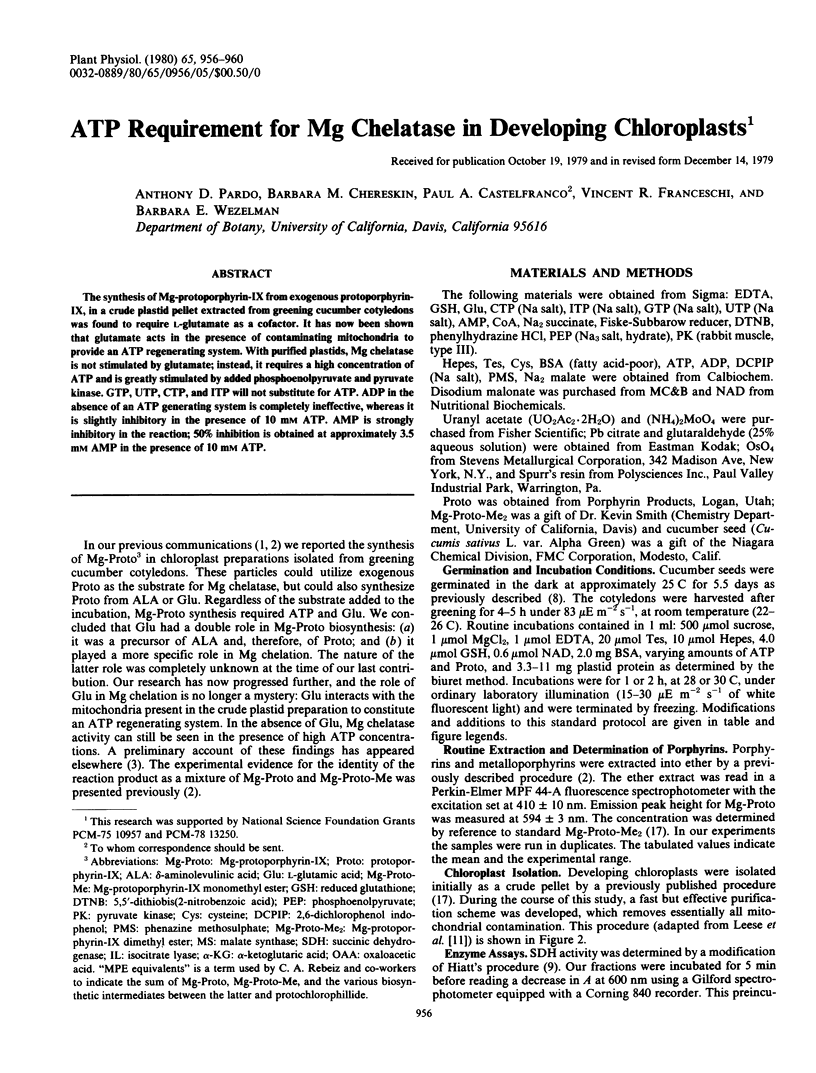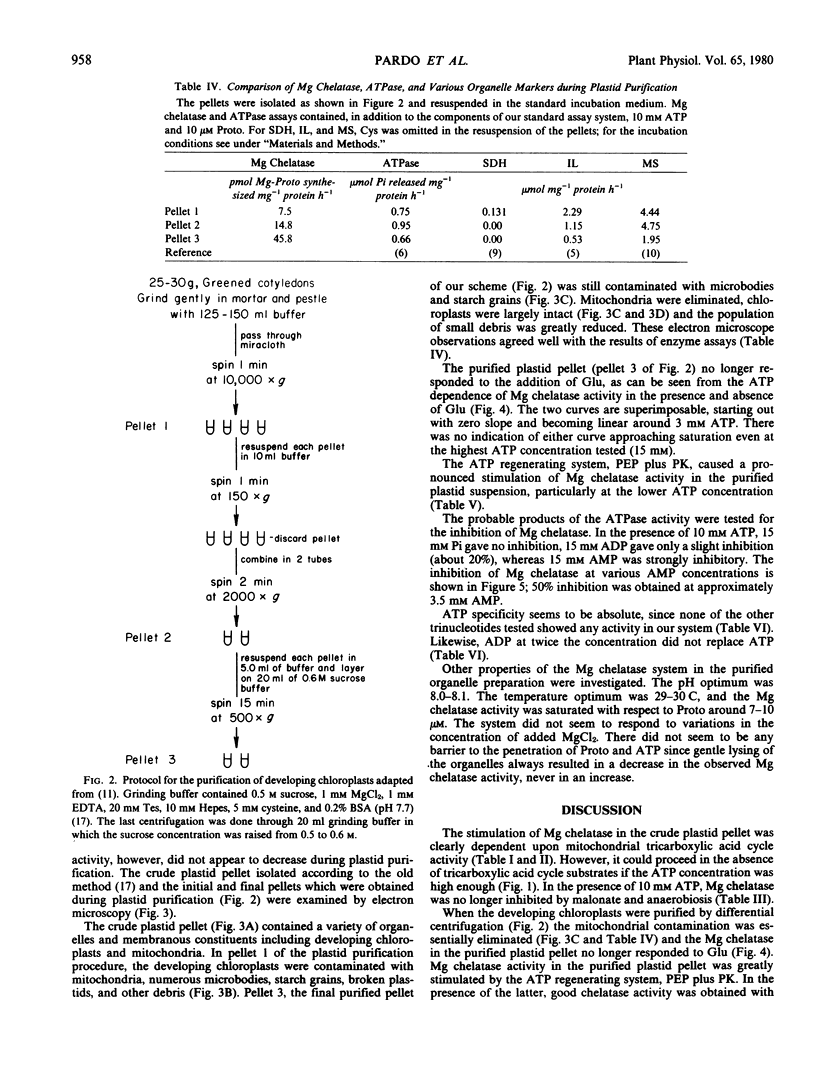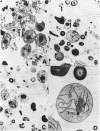Abstract
The synthesis of Mg-protoporphyrin-IX from exogenous protoporphyrin-IX, in a crude plastid pellet extracted from greening cucumber cotyledons was found to require l-glutamate as a cofactor. It has now been shown that glutamate acts in the presence of contaminating mitochondria to provide an ATP regenerating system. With purified plastids, Mg chelatase is not stimulated by glutamate; instead, it requires a high concentration of ATP and is greatly stimulated by added phosphoenolpyruvate and pyruvate kinase. GTP, UTP, CTP, and ITP will not substitute for ATP. ADP in the absence of an ATP generating system is completely ineffective, whereas it is slightly inhibitory in the presence of 10 mm ATP. AMP is strongly inhibitory in the reaction; 50% inhibition is obtained at approximately 3.5 mm AMP in the presence of 10 mm ATP.
Full text
PDF




Images in this article
Selected References
These references are in PubMed. This may not be the complete list of references from this article.
- Castelfranco P. A., Schwarcz S. Mg-protoporphyrin-IX and delta-aminolevulinic acid synthesis from glutamate in isolated greening chloroplasts. Mg-protoporphyrin-IX synthesis. Arch Biochem Biophys. 1978 Mar;186(2):365–375. doi: 10.1016/0003-9861(78)90447-2. [DOI] [PubMed] [Google Scholar]
- Castelfranco P. A., Weinstein J. D., Schwarcz S., Pardo A. D., Wezelman B. E. The Mg insertion step in chlorophyll biosynthesis. Arch Biochem Biophys. 1979 Feb;192(2):592–598. doi: 10.1016/0003-9861(79)90130-9. [DOI] [PubMed] [Google Scholar]
- Dailey H. A., Jr Purification and characterization of the membrane-bound ferrochelatase from Spirillum itersonii. J Bacteriol. 1977 Oct;132(1):302–307. doi: 10.1128/jb.132.1.302-307.1977. [DOI] [PMC free article] [PubMed] [Google Scholar]
- Hardy S. I., Castelfranco P. A., Rebeiz C. A. Effect of the hypocotyl hook on greening in etiolated cucumber cotyledons. Plant Physiol. 1970 Nov;46(5):705–707. doi: 10.1104/pp.46.5.705. [DOI] [PMC free article] [PubMed] [Google Scholar]
- Hiatt A. J. Preparation & some properties of soluble succinic dehydrogenase from higher plants. Plant Physiol. 1961 Sep;36(5):552–557. doi: 10.1104/pp.36.5.552. [DOI] [PMC free article] [PubMed] [Google Scholar]
- REYNOLDS E. S. The use of lead citrate at high pH as an electron-opaque stain in electron microscopy. J Cell Biol. 1963 Apr;17:208–212. doi: 10.1083/jcb.17.1.208. [DOI] [PMC free article] [PubMed] [Google Scholar]
- Smith B. B., Rebeiz C. A. Chloroplast Biogenesis: XXIV. Intrachloroplastic Localization of the Biosynthesis and Accumulation of Protoporphyrin IX, Magnesium-Protoporphyrin Monoester, and Longer Wavelength Metalloporphyrins during Greening. Plant Physiol. 1979 Feb;63(2):227–231. doi: 10.1104/pp.63.2.227. [DOI] [PMC free article] [PubMed] [Google Scholar]
- Spurr A. R. A low-viscosity epoxy resin embedding medium for electron microscopy. J Ultrastruct Res. 1969 Jan;26(1):31–43. doi: 10.1016/s0022-5320(69)90033-1. [DOI] [PubMed] [Google Scholar]
- WATSON M. L. Staining of tissue sections for electron microscopy with heavy metals. J Biophys Biochem Cytol. 1958 Jul 25;4(4):475–478. doi: 10.1083/jcb.4.4.475. [DOI] [PMC free article] [PubMed] [Google Scholar]
- Weinstein J. D., Castelfranco P. A. Protoporphyrin IX biosynthesis from glutamate in isolated greening chloroplasts. Arch Biochem Biophys. 1977 Jan 30;178(2):671–673. doi: 10.1016/0003-9861(77)90239-9. [DOI] [PubMed] [Google Scholar]
- de la Roche A. I. Increase in linolenic Acid is not a prerequisite for development of freezing tolerance in wheat. Plant Physiol. 1979 Jan;63(1):5–8. doi: 10.1104/pp.63.1.5. [DOI] [PMC free article] [PubMed] [Google Scholar]



